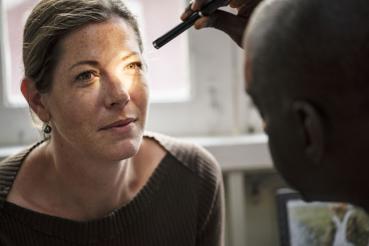There’s no doubt that social media has forever changed how we view ourselves. Between the high-quality cameras in our phones and scrolling through perfectly curated and edited selfies on Instagram, minor imperfections can start to feel like eye-catching flaws.
Then, COVID-19 shut down the country, and we quickly shifted to working remotely from our home offices (or kitchens or couches or beds). In-person meetings shifted to virtual video calls, and we were forced to make ourselves and our spaces screen-ready every day. And while videoconference meetings somewhat manage to mimic live ones, there’s a major difference: the self-view function.
We’ve all caught ourselves staring at our own faces, and not everyone likes what they see. In fact, there has been a significant uptick in those exploring their cosmetic and surgical options since the pandemic began. According to the American Academy of Facial Plastic and Reconstructive Surgery, the pandemic has led to a 10% increase in cosmetic surgery.
Cosmetic procedures are also on the rise. The Aesthetic Plastic Surgery National Databank reports that Botox has increased by 54% and filler treatments are up by 75% from 2019.
You Might Also Like
Cosmetic Procedures On the Rise During the Pandemic
For Rush facial plastic and reconstructive surgeon Peter Revenaugh, MD, this phenomenon isn’t surprising.
“We’ve never had to look at our faces this much for this long,” he says. “It’s rare for most of us to have hours on camera every day.” In addition, he says, the fact that patients can recover in privacy without having to avoid work or social functions appears to be another deciding factor.
What’s right for you?
These are some of the popular procedures and treatments:
- Rhinoplasty: This surgical procedure changes the shape of the nose for medical purposes, cosmetic reasons or a combination of both. According to Revenaugh, it’s one of the most common procedures patients want to discuss with him. After surgery, patients will have a cast on their nose and bruising around the eyes for a few weeks.
- Face-lifts, neck-lifts and eyelid surgery: Patients looking for a more youthful appearance frequently opt for a face-lift to reduce the look of sagging skin on the face and jawline. Revenaugh notes that though face-lifts are common, they sometimes are paired with neck-lifts to get the result that the patient seeks. Similarly, upper and lower eyelid surgery is often paired with a face-lift to improve the overall results.
- Botox: Botulinum toxin, more commonly known as Botox, is a relatively safe medical and cosmetic procedure. Though it can be used to treat conditions like migraines and excessive sweating, it’s primarily known as a way to reduce the appearance of wrinkles. A small amount of Botox is injected into the skin to prevent the muscles in your face from moving, which ends up temporarily reducing and preventing fine lines. This outpatient procedure works quickly and requires little recovery time. The effects generally last a few months.
- Fillers: While similar to Botox, injectable dermal fillers are generally used to fill lines and wrinkles around the mouth and nose rather than focusing on the muscles. Though they carry a slightly higher risk (e.g., rare infections, odd lumps) than Botox, fillers are common and very safe. The effects typically last for a year.
Expectation management
Cosmetic dermatologists and plastic surgeons can help you understand what certain procedures can or cannot accomplish. They also can show patients that insecurity surrounding a physical feature may not be solved by “fixing” the problem.
Body dysmorphic disorder, or BDD, is when people have an intense focus on perceived defects or flaws that disrupt their life. For those with BDD, seemingly minor imperfections can cause significant stress and anxiety. So, while a smaller nose or flatter stomach may offer people a respite from distress, it’s likely they’ll simply shift their focus to a different imperfection. That’s why Revenaugh screens all potential patients for BDD before and during their consultations.
“We keep an eye out for patients with an unreasonable amount of focus on the body, which can be a sign of BDD,” Revenaugh says. “Red flags include heightened expectations or highly specific demands about what they want their results to be, bringing in hundreds of pictures of a particular body part or a recent major life event.”
Taking the plunge
If you decide that you’re ready to take the next step toward a cosmetic procedure, Revenaugh suggests coming in for a consultation and getting information from a professional instead of finding it online.
“Consumer info about cosmetic procedures is all over the board,” Revenaugh says. “The quality of information for patients on social media, for example, is awful. There are a limited number of qualified sources available: the American Society of Plastic Surgery website is great for research, and Rush has a nice website that goes over facial procedures. Patients can find information like cost and the downtime they can expect, but speaking to a doctor is always the best bet.”
Instead of trying to sort through dubious information on your own, Revenaugh advises prospective patients to meet him virtually or in his office with an idea of what they’re looking for. He then discusses options and sets expectations in terms of realistic results and what it could take to get them.
For this reason, Revenaugh warns against bringing in images of your face that you have digitally tweaked, as those changes are frequently difficult to mimic. Instead, doctors have many ways of showing what the results of a given procedure might be, whether that’s physically demonstrating a neck-lift on you or using digital technology to illustrate which nasal modifications are possible.
Rush dermatologist Sonya B. Kenkare, MD, agrees that expectation management is essential.
“The point of a consultation is to get an understanding of where the individual is coming from,” Kenkare says. “We want to assess expectations and also make sure those expectations are realistic. Looking 50 years younger might not be an option for you, but we can give you a refresh using a variety of treatments.”
As you’re preparing for a dermatological appointment, there are some minor steps you can take to ensure the best results possible. Avoid taking blood-thinning supplements like aspirin or ibuprofen for about a week before your appointment and avoid alcohol and sun exposure the day prior.
“At the end of the day, we’re trying to make patients happy,” Kenkare says. “Hopefully, soon we’ll be in a position where we don’t have to wear masks anymore, and people will be able to unveil a fresh version of themselves.”
Revenaugh acknowledges that there still can be a stigma attached to plastic surgery, but it’s fading, and the positive results are worth it for many. “Patients sometimes feel guilty or shameful about getting plastic surgery, and they shouldn’t,” he says. “They think, ‘I’m not vain! I’m not the kind of person who cares about my appearance!’ But the reality is people deserve to look how they feel, especially when they have to look at themselves for 40 hours a week.”




